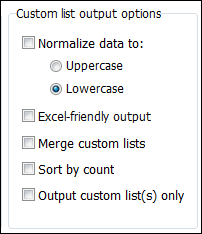MARC Analysis changes (in 2.48)
Although it was possible to save a set of MARC Analysis options, and load them at a later time, the set of options that would be loaded by default was somewhat unpredictable. This version resolves this confusion.
First, we have added a second statusbar to the starting panel of MARC Analysis that displays the options file currently in effect:
In addition, whenever you are editing the options, the name of the current options file will be displayed in the form's title bar:
Second, any time the Load button is pressed to load another set of options, this statusbar will be updated.
Third, any time the Save As button is used to create a new set of options, that new set of options will be loaded and again, the second status bar will be updated.
Lastly, and perhaps most importantly, the set of options in effect when the utility is closed will always be the options that are loaded the next time MARC Analysis runs.
Custom lists changes
We've added a new capability to the Custom Lists feature.
As you know, you can define up to 8 custom lists that instruct MARC Analysis to create frequency tables for any variable MARC Tag/Subf1).
For example, if we specify a custom list using
100e
and then run MARC Analysis, we will get a table like the following2):
| Custom list for 100e | |
|---|---|
| author | 571724 |
| composer | 23532 |
| illustrator | 9177 |
| artist | 6665 |
| performer | 5061 |
| lyricist | 4826 |
| [many more entries] | |
But what if we wanted a table of all of the relationship designators in our database, with the most frequently used appearing at the top?
Version 2.48 makes this possible by adding an option to merge, or cumulate, whatever custom lists are defined.
Here are the options now available on the Custom lists page:
To use the new options to achieve the stated objective, first define the custom lists that will gather the relator data from the MARC fields where it occurs: collect all of the relationship designators from the 1XX and 7XX, using six custom lists:
In previous versions, running MARC Analysis with these options would create six separate tables, like the one above. But now, when we can tick the new Merge custom lists checkbox, we will get the results of all six lists rolled into one.
-------------------------------------------------------------------------------- CUSTOM LIST MERGE RESULTS Tags analyzed: 100e 110e 111j 700e 710e 711j -------------------------------------------------------------------------------- author 722218 editor 192910 actor 75567 issuing body 65966 illustrator 63710
Additionally, we can now
- normalize data to either uppercase or lowercase (in the past, normalization always shifted the data to uppercase), and
- sort the frequency table by the count (in the past, the table was always sorted by the data value in the first column)
- generate a more 'Excel-friendly' output. When selected, list output will be separated using tabs instead of a colon followed by blank spaces. This will make it easier to grab a custom list and paste it into a spreadsheet, etc.
Notes
At present, the 'Excel-friendly' option applies only to custom lists.
When Merge Custom lists is defined, any individual lists that are defined will still be output in the usual manner. The merged list is an extra list that appears at the end of the report; it does not supersede the defined custom lists.
By default, MARC Analysis generates custom lists in the following format
Custom List for 700e
actor: 291
adapter:1
artist: 27
author: 66
cast: 1
colorist:5
composer expression:27
directo:1
director:178
ed: 1
![[MARC Report]](/w/lib/tpl/dokubook/images/logo.jpg)




